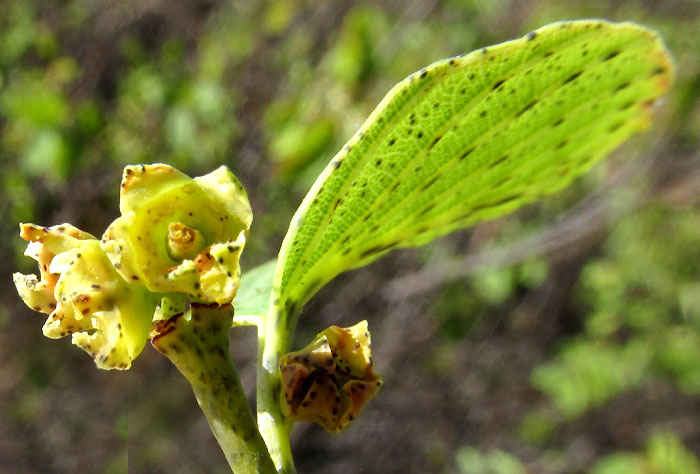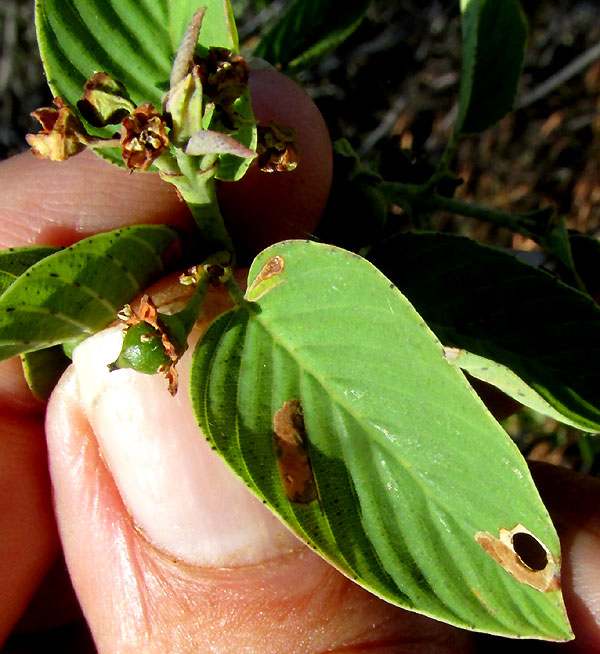Excerpts from Jim Conrad's
Naturalist Newsletter
entry dated May 18, 2022, notes from a camping trip among hills about 7kms ENE of Tequisquiapan, Querétaro state, MÉXICO
elevation about 2020m (6600 ft), near N20.57°, W99.85°
HUMBOLDT COYOTILLO FLOWERING

On a rocky, grassy slope of a hill composed mostly of volcanic rhyolite, near La Higuera, a small, much branching tree caught my eye, for in this late dry season, sun-parched landscape, where the rains were coming late this year, it was flowering and leafing out, shown above.
Moreover, freshly emerged flowers, leaves and stems were all covered with tiny, black dots, as if being attacked by a fungal disease. Some branches bore flowers that had been pollinated and now the ovaries were expanding into immature fruits, and those parts, except for the ovaries, also bore black dots:

With the flowers curiously consisting of five hardly visible, yellowish green petals and five low, triangular sepals framing a greenish, doughnut-shaped disc surrounding the ovary, and with simple leaves exhibiting numerous conspicuous secondary veins forming a "herringbone pattern," this was clearly a member of the Buckthorn Family, the Rhamnaceae. Though in the temperate zone not many members of the Buckthorn Family are encountered, in the world's subtropical and tropical areas, especially the drier parts, as here, often shrubby and small-tree members of the Buckthorn Family are conspicuous. And in this area, when I've been identifying members of the Buckthorn Family, often I've noticed mention of a certain genus featuring tiny, black dots just like these: The genus Karwinskia.
Karwinskia is a distinctive genus not only because of its black dots, but also because it bears none of the thorns or spines typical of the Buckthorn Family. The genus is named for the Bavarian naturalist Baron Wilhelm Friedrich Karwinsky von Karwin, who collected plants in Mexico from 1826-1831, and 1840. Several organisms are named for him.
About 18 species currently are placed in the genus Karwinskia, all being endemic just to the Americas. Only one species occurs in the US but in Mexico there are 15, and in our Bajío region of semiarid, upland central Mexico there are three. Our little tree is the most widespread and variable of the genus, KARWINSKIA HUMBOLDTIANA, in English often known as the Humboldt Coyotilla.
Alexander von Humboldt, for whom the species is named, visited our area in 1803, when he traveled the road between San Juan del Río and Querétaro city. Karwinskia humboldtiana bears an English name because it's the one species making it into the US, being commonly distributed from southwestern Texas through semiarid Mexico south to the Yucatan Peninsula and Chiapas. Below is what our tree looks like in its habitat:

It's assumed that plants such as most members of the Buckthorn Family produce spines to dissuade animals from browsing on them. Humboldt Coyotilla has no spines, so how does it manage? I bet the black dots have something to do with it.
Veternarians have documented cattle being poisoned who fed on the tree, and the medical world knows that the fruits can be lethal. María Victoria Bermúdez de Rocha and others in an undated clinical report entitled "Intoxicación de una familia por Karwinskia humboldtiana (Tullidora)" reports on an entire family in northern Mexico who suffered accidental poisoning by eating the ripe fruits of Humboldt Coyotilla. Of ten who ate the fruit, three died. Possibly the most lethal human poisoning was in 1917 when 106 Mexican soldiers ate the fruit, and 20% died. These people weren't eating the tree's dot-covered vegetative parts, but at least it's clear that the species has potent toxins at its disposal, and often such toxins are gathered in a species' vegetative glands, such as these black dots could be.
Often it's the case that chemical compounds that are toxic, even lethal, in one dosage or usage, are medicinal in another. The online "Atlas de las Plantas de la Medicina Tradicional Mexicana" reports that traditionally the tree's sap has been applied to wounds as a cure, and infected wounds have been washed in an infusion of the leaves and roots. To cure amoebic dysentery, leaves were ground and the strained extract was drunk. Other cures are mentioned for fevers, gallstones, headache, rheumatism, convulsions, malaria, tetanus, and to cause abortion.